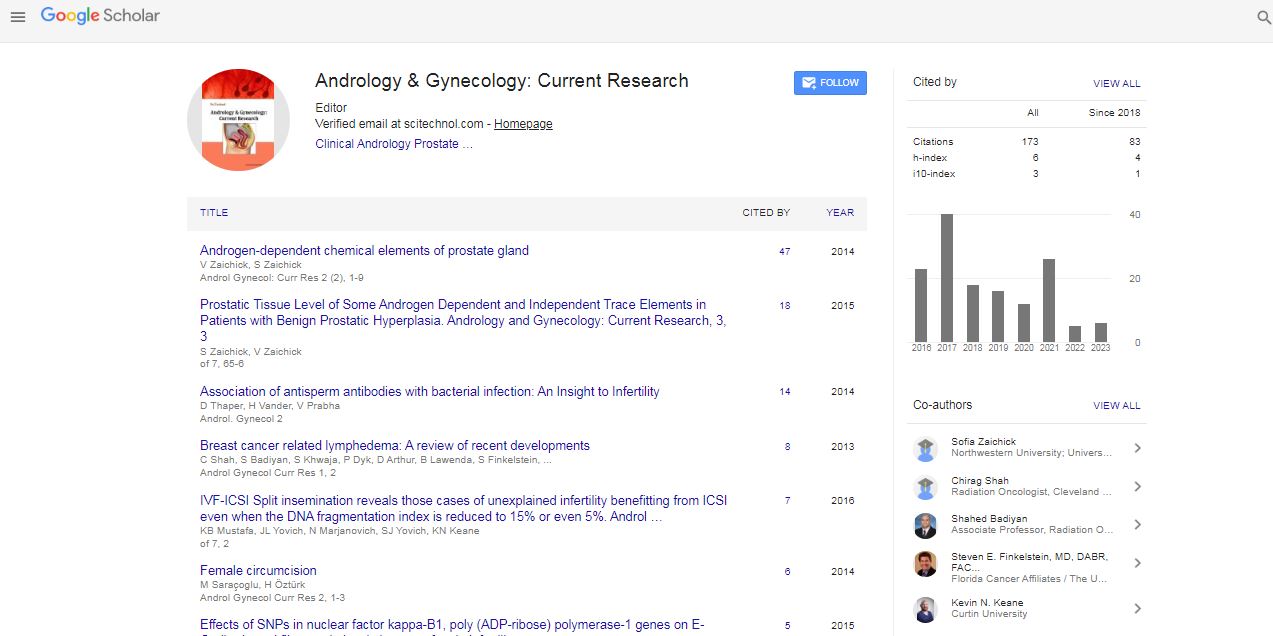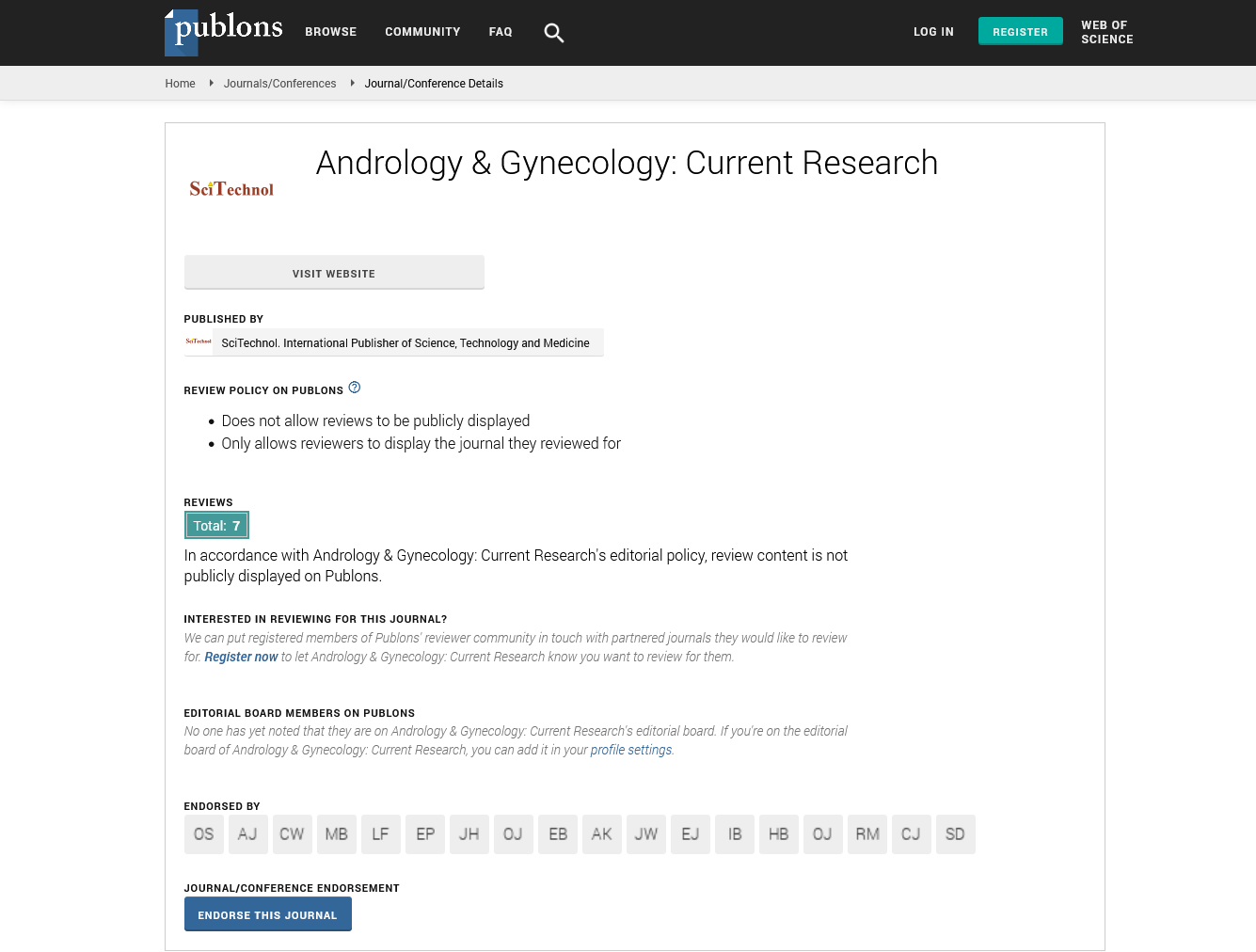Research Article, Androl Gynecol Curr Res Vol: 7 Issue: 1
Shock Wave Therapy inVasculogenic Erectile Dysfunction
Pavel Kyzlasov*
Urology and Andrology IPPE of A.I. Burnazyan SSC FMBC of FMBA of Russia, Russia
*Corresponding Author : Pavel Kyzlasov
Urology and Andrology IPPE of A.I.
Burnazyan SSC FMBC of FMBA of Russia, Russia
Tel: 74951909352
E-mail: dr.kyzlasov@mail.ru
Received: January 25, 2019 Accepted: March 15, 2019 Published: March 31, 2019
Citation: Kyzlasov P (2018) Shock Wave Therapy in Vasculogenic Erectile Dysfunction. Androl Gynecol: Curr Res 7:1. doi: 10.4172/2327-4360.1000169
Abstract
Objective: The aim of this study is to evaluate the response to shock wave therapy in a group of patients with vasculogenic erectile dysfunction after underwent deep dorsal vein embolization. Methods: A clinical record of 30 patients from 26 to 45 years with a clinical diagnosis of vasculogenic ED of more than six months and without venous leakage from legs of the penis, and cancer pathology has not been identified. Patient diagnostics consisted of questionnaire (IIEF-5), Penile Pharmacological Doppler Ultrasonography and CT Cavernosography. After confirming the diagnosis of vasculogenic ED, they all underwent deep dorsal vein embolization. Then the second stage all patients received a treatment by the shockwave device - “BTL-6000 SWT TOPLINE” (BTL Corporate). The effectiveness of therapy was evaluated by two criteria: the IIEF-5 score and evaluation of penile blood flow. Results: The average IIEF-5 score has greatly increased from 16.7 at baseline to 22.2 post treatment. Out of 30 patients, 26 (81%) subjectively noted a persistent improvement in erectile function. An increase in the penile blood flow in the right cavernosum artery from 17.7 mm Hg at baseline to 34 mm Hg post treatment, in the left cavernosum artery from 13.2 mm Hg to 28.3 mm Hg, in the right dorsal artery from 18 mm Hg to 32 mm Hg and in the left dorsal artery from 16 mm Hg to 33 mm Hg. As well as, increase in the diameter of the cavernous bodies was noted. Conclusion: The results of this study indicate erectile dysfunction treatment should have a personalized approach. Shock wave therapy in combination with the reduction of venous outflow may be an alternative to revascularization of the penis.
Keywords: Erectile dysfunction; Deep dorsal vein embolization; Shock wave therapy; Non-invasive; iief; Ultrasonography; Ct cavernosography
Keywords
Erectile dysfunction; Deep dorsal vein embolization; Shock wave therapy; Non-invasive; iief; Ultrasonography; Ct cavernosography
Introduction
Erectile dysfunction (ED) is defined as the persistent inability to attain or maintain an erection that is sufficient for satisfactory sexual intercourse until ejaculation or until the cessation of erotic stimulation. The pathophysiology of ED may be vasculogenic, neurogenic, anatomical, hormonal, drug-induced, and/or psychogenic [1,2]. The Massachusetts Male Aging Study reported an overall prevalence of 52% in men aged 40 to 70, while the Cologne study estimated a prevalence of 19.2% in men between the ages of 30 and 80 with an age-related increase from 2.3% to 53.4%. It therefore has a significant negative impact on the quality of life of sufferers and their partners [3-5].
As a relatively novel approach in regeneration medicine, defocused low-energy shock wave therapy (DL-ESWT) has shown great potential and promising evidences, especially for the treatment of various disorders such as tissue trauma and defects [6-10]. At present, ESWT has been applied to clinical therapy for ED, and many studies have shown that ESWT can achieve satisfactory therapeutic effects [11-13].
The mechanotransduction theory explains the process, how mechanical stimulation is perceived in living cells [14,15] by synthesis of nitric oxide (NO) and increase in vascular endothelial growth factor (VEGF), thereby creating a potential for treatment of several conditions such as bone non-unions [16,17], chronic wounds [18,19], ischemic heart disease [20,21] and nephropathy [22].
Also known in the literature, an interventional approach to restore sufficient penile erection using selective embolization of insufficient veins have been clinically studied as an alternative to invasive surgical treatment [23,24]. Success of the interventional approach makes this procedure an attractive treatment option, as it is less invasive and more cosmetically pleasing than surgical approach [23].
The present study examines the previously unknown effect of a treatment by a dedicated device delivering shockwaves adjusted to the male sexual organ, on patients suffering from vasculogenic ED after underwent deep dorsal vein embolization.
Materials and Methods
Clinical records of 30 patients from 26 to 45 years (35.5+9.5) with a clinical diagnosis of vasculogenic ED of more than six months and without venous leakage from legs of the penis, and cancer pathology has not been identified. Patient diagnostics consisted of the International Index of Erectile Function questionnaire (IIEF- 5), Penile Pharmacological Doppler Ultrasonography and CT Cavernosography. During Penile Doppler Ultrasonography we estimated of cavernous tissue (availability starry sky) and evaluated of penile vessels. And assessment of the presence of venous leakage from legs of the penis by CT Cavernosography. After confirming the diagnosis of vasculogenic ED, they all underwent deep dorsal vein embolization at Department of Urology and Andrology in IPPE of A.I. Burnazyan SSC FMBC of FMBA of Russia (Figure 1).
Then the second stage of therapy was carried out, each patient received a treatment by the shockwave device - “BTL-6000 SWT TOPLINE” (BTL Corporate). Scheme of Shock Wave Therapy (SWT): Each treatment session included a 3-minute application of the therapeutic head in 5–6 points (four on the penis and two on the crura) and the application of 300 pulses in the treatment mode of erectile dysfunction at each point (Figure 2). An average of 18,000 shock impulses per patient per 9-week course of therapy (Figure 3). All sessions were outpatient visits, and no anaesthetic was used. The IIEF-5 score and evaluation of penile blood flow for all patients was measured at two stages: before the first session, at the end of the last session. During the examinations, known adverse effects of the treatment were investigated, such as pain, paresthesia, and skin lesions on the penis. Contraindications for patients to shock wave therapy were: acute bacterial infection in the area of exposure, open wound in the area of impact, cancer and other tumor diseases, vascular thrombosis, blood clotting disorders and anticoagulants, impaired sensitivity in the focal area, acute phase of infectious disease
Results
The average IIEF-5 score has greatly increased from 16.7 at baseline to 22.2 post treatment. Out of 30 patients, 26 (81%) subjectively noted a persistent improvement in erectile function (Diagram 1).An increase in the penile blood flow in the right cavernosum artery from 17.7 mmHg at baseline to 34 mmHg post treatment, in the left cavernosum artery from 13.2 mm Hg to 28.3 mm Hg, in the right dorsal artery from 18 mm Hg to 32 mm Hg and in the left dorsal artery from 16 mm Hg to 33 mm Hg (Diagram 2).As well as increase in the diameter of the cavernous bodies was noted.
Discussion
This study involved number of patients with vasculogenic ED to have been treated with SWT, after underwent deep dorsal vein embolization. The results show a significant improvement in erectile dysfunction, based on the IIEF-5 score and evaluation of penile blood flow in patients undergoing shock wave therapy. Patients received 9 weeks sessions of SWT without requiring anaesthesia and with no evidence of complications. During and after the procedure, two evaluations were carried out that showed favourable results, with an IIEF-5 score improvement in patients undergoing treatment with respect to the baseline measurement. These results are equivalent to those reported in the literature in studies that applied similar methods [25, 26]. But in the literature there is no information about the effectiveness of shock wave therapy after embolization of the deep dorsal vein in patients with vasculogenic ED.
The success of this therapy is based on its safety and ease of application, as well as it being the only therapy that seeks to modify the pathophysiology of the disease. Its effect on erectile dysfunction is due to the induction of different physiological components such as the nitric oxide synthase enzyme, endothelial growth factor, proliferating cell nuclear antigen, among other vasodilators, as well as the stimulation of stem cell migration which together lead to increased angiogenesis, thus improving the flow and the quality of erections [14-22].
The positive side of the study is one of the first small studies of the effectiveness of shock wave therapy after embolization of the deep dorsal vein in patients with vasculogenic ED, include opportunity to evaluate the IIEF-5 score and penile blood flow. However, the shortcomings of the study are experimental study.
In the future studies, we propose that the best design to evaluate the effectiveness of the therapy is the placebo-controlled clinical trial; in addition, the evaluated parameters should be broadened in questionnaires on sexual satisfaction, quality of life, and erection hardness score.
Conclusion
The results of this study indicate erectile dysfunction treatment should have a personalized approach. Shock wave therapy in combination with the reduction of venous outflow may be an alternative to revascularization of the penis.
Conflict of Interest
Authors declare no conflict of interest exists.
References
- Gratzke C, Angulo J, Chitaley K, Dai YT, Kim NN, et al. (2010) Anatomy, physiology, and pathophysiology of erectile dysfunction. J Sex Med 7:445-475.
- NIH Consensus Conference (1993) Impotence NIH Consensus Development Panel on Impotence. JAMA270:83–90.
- Feldman HA, Goldstein I, Hatzichristou DG, Krane RJ, McKinlay JB (1994) Impotence and its medical and psychosocial correlates: Results of the Massachusetts Male Aging Study. J Urol 151:54-61.
- Braun M, Wassmer G, Klotz T, Reifenrath B, Mathers M, et al. (2000) Epidemiology of erectile dysfunction: Results of the “Cologne Male Survey. Int J Impot Res.12:305–311.
- Salonia A, Castagna G, Saccà A, Ferrari M, Capitanio U, et al. (2012) Is erectile dysfunction a reliable proxy of general male health status? The case for the International Index of Erectile Function-Erectile Function domain. J Sex Med 9:2708-2715.
- Hayashi D, Kawakami K, Ito K, Ishii K, Tanno H, et al. (2012) Low-energy extracorporeal shock wave therapy enhances skin wound healing in diabetic mice: A critical role of endothelial nitric oxide synthase. Wound Repair Regen 20: 887-895.
- Foldager CB, Kearney C, Spector M (2012) Clinical application of extracorporeal shock wave therapy in orthopedics: focused versus unfocused shock waves. Ultrasound Med Biol 38: 1673-1680.
- Aqil A, Siddiqui MR, Solan M, Redfern DJ, Gulati V, et al.(2013) Extracorporeal shock wave therapy is effective in treating chronic plantar fasciitis: A meta-analysis of RCTs. Clinical Clin Orthop Relat Res 471: 3645-3652.
- Cayton T, Harwood AE, Smith GE, Totty JP, Carradice D, et al.(2017) “Extracorporeal shockwave therapy for the treatment of lower limb intermittent claudication: study protocol for a randomised controlled trial (the SHOCKWAVE 1 trial).Trials 18: 104.
- Zissler A, Steinbacher P, Zimmermann R, Pittner S, Stoiber W, et al. ( 2017) Extracorporeal shock wave therapy accelerates regeneration after acute skeletal muscle injury. Am J Sports Med 45:676–684.
- Gruenwald I, Appel B, Vardi Y (2012) Low├ó┬?┬Éintensity extracorporeal shock wave therapy: A novel effective treatment for erectile dysfunction in severe ED patients who respond poorly to PDE5 inhibitor therapy. J Sex Med 9: 259–264.
- Clavijo RI, Kohn TP, Kohn JR2, Ramasamy R(2017) Effects of low-intensity extracorporeal shockwave therapy on erectile dysfunction: A systematic review and meta-analysis. J Sex Med. 14: 27-35.
- Lu Z, Lin G, Reed-Maldonado A, Wang C, Lee YC, et al. (2017)Low-intensity extracorporeal shock wave treatment improves erectile function: a systematic review and meta-analysis. European Urology 71: 223–233.
- Wang N, Tytell JD, Ingber DE (2009) Mechanotransduction at a distance: Mechanically coupling the extracellular matrix with the nucleus. Nat Rev Mol Cell Biol 10:75-82.
- Frairia R, Berta L (2011) Biological effects of extracorporeal shock waves on fibroblasts. A review. Muscles Ligaments Tendons J1:138-147
- Haupt G, Haupt A, Ekkernkamp A, Gerety B, Chvapil M (1992) Influence of shock waves on fracture healing. Urology 39:529-532.
- Valchanou VD, Michailov P (1991) High energy shock waves in the treatment of delayed and nonunion of fractures. Int Orthop 15:181-184.
- Larking AM, Duport S, Clinton M, Hardy M, Andrews K (2010) Randomized control of extracorporeal shock wave therapy versus placebo for chronic decubitus ulceration. Clin Rehabil 24:222-229.
- Saggini R, Figus A, Troccola A, Cocco V, Saggini A, et al. (2008) Extracorporeal shock wave therapy for management of chronic ulcers in the lower extremities. Ultrasound Med Biol 34:1261–1271.
- Yang P, Guo T, Wang W, Peng YZ, Wang Y, et al. (2013) Randomized and double-blind controlled clinical trial of extracorporeal cardiac shock wave therapy for coronary heart disease. Heart Vessels 28:284-291.
- Wang Y, Guo T, Cai HY, Ma TK, Tao SM, et al. (2010) Cardiac shock wave therapy reduces angina and improves myocardial function in patients with refractory coronary artery disease. Clin Cardiol 33:693-699.
- Hanna M, Pedersen D, Lund M, Marcussen N, Lund L (2012) Low energy ESWT, a novel treatment for diabetic nephropathy (animal study). J Endourol 26:A6.
- Rebonato A, Auci A, Sanguinetti F, Maiettini D, Rossi M, et al.(2014) Embolization of the periprostatic venous plexus for erectile dysfunction resulting from venous leakage. J Vasc Interv Radiol 25:866-872.
- Berardinucci D, Morales A, Heaton JP, Fenemore J, Bloom S (1996) Surgical treatment of penile veno-occlusive dysfunction: is it justified? Urology 47:88-92.
- Chung E, Cartmill R (2015) Evaluation of clinical efficacy, safety and patient satisfaction rate after low-intensity extracorporeal shockwave therapy for the treatment of male erectile dysfunction: An Australian first open-label single-arm prospective clinical trial. BJU Int 115:46–49.
- Reisman Y, Hind A, Varaneckas A, Motil I(2015) Initial experience with linear focused shockwave treatment for erectile dysfunction: A 6-month follow-up pilot study. Int J Impot Res 27:108-112.
 Spanish
Spanish  Chinese
Chinese  Russian
Russian  German
German  French
French  Japanese
Japanese  Portuguese
Portuguese  Hindi
Hindi 







